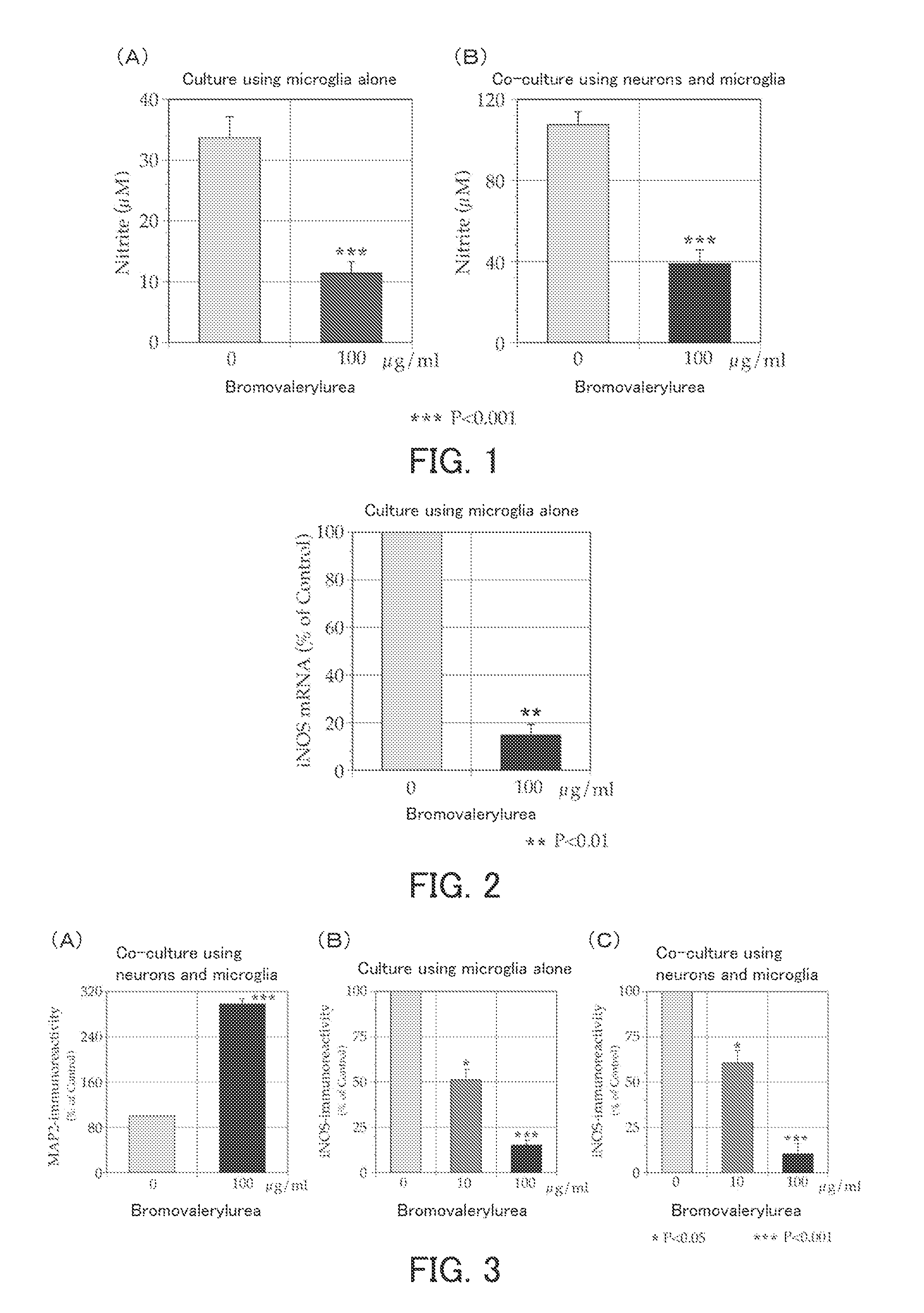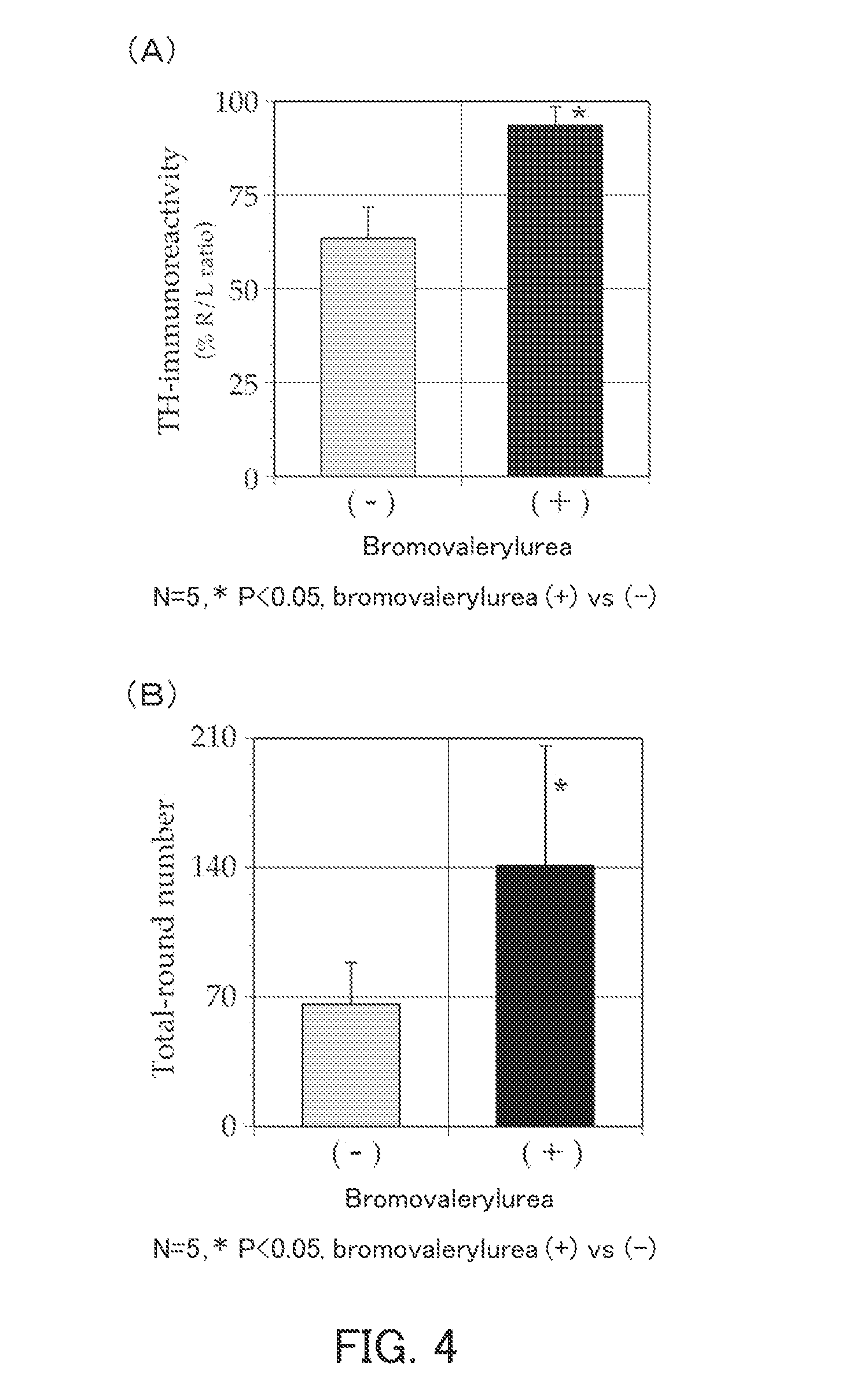Immune cell activation inhibitor and use thereof
- Summary
- Abstract
- Description
- Claims
- Application Information
AI Technical Summary
Benefits of technology
Problems solved by technology
Method used
Image
Examples
example 1
[0076]The present example examined the effect of bromovalerylurea on Parkinson's disease.
[0077](1) Inhibition of Release of Nitric Oxide
[0078]As described below, newborn rat-derived primary culture microglia (MG) were cultured in the presence of bromovalerylurea and LPS (lipopolysaccharide), and the amount of nitric oxide, which is a neurocytotoxic factor, released from the MG was measured.
[0079]As culture systems, a culture system containing the MG alone and a co-culture system containing the MG and rat-derived primary culture cerebral cortical neurons were provided to carry out culture. The medium used was a serum-free medium (pH 7.4) containing: a Dulbecco's modified Eagle's medium (DMEM) as a basal medium; LPS at a final concentration of 1 μg / ml; and bromovalerylurea at a final concentration of 100 μg / ml. The culture conditions were set to 37° C., 48 hours, and 5% CO2. The concentration of nitrite ions in each of the culture solutions at the end of the culture was measured using...
example 2
[0094]The present example examined the effect of bromovalerylurea on cerebral infarction.
[0095](1) Inhibition of tissue loss in cerebral infarction model rats
[0096]Cerebral infarction model rats each having cerebral infarction induced by 90-minute transient occlusion of the right middle cerebral artery were used to examine whether bromovalerylurea inhibits tissue loss.
[0097]As the model rats, male Wistar rats were used (Matsumoto et al., Journal of Cerebral Blood Flow & Metabolism (2008) 28: pp. 149-163). By magnetic resonance imaging (MRI), only the model rats in which cerebral infarction had been induced sufficiently were selected (n=4). To these model rats, drinking water containing 500 mg / l bromovalerylurea was administered orally for 14 days in such a manner that each rat drank an average of 25 ml of the drinking water per day. On Day 16 from the last day of oral administration, each model rat was dissected, and a middle cerebral artery perfusion region in the brain was collect...
example 3
[0111]The present example examined the effect of bromovalerylurea on sepsis.
[0112](1) Effect of improving survival rate
[0113]The cecum of each of 8-week old male Wistar rats was ligated, and two perforations were formed with an 18-gauge injection needle in the ligated part of the cecum. Thus, perforative peritonitis was caused to prepare rat sepsis models. Immediately after the preparation of the model rats, 10 ml of a commercially available maintenance infusion solution (SOLITA T3, Ajinomoto Pharmaceuticals Co., Ltd.) in which bromovalerylurea had been dissolved at a final concentration of 500 μg / ml was injected subcutaneously to the model rats. As a control group, the same amount of the maintenance infusion solution not containing bromovalerylurea was injected subcutaneously. Thereafter, the injection was performed in the same manner about every 12 hours. Also, rats subjected only to laparotomy, i.e., the incision of the skin and the peritoneum with no injury to the intestinal tra...
PUM
 Login to View More
Login to View More Abstract
Description
Claims
Application Information
 Login to View More
Login to View More - R&D
- Intellectual Property
- Life Sciences
- Materials
- Tech Scout
- Unparalleled Data Quality
- Higher Quality Content
- 60% Fewer Hallucinations
Browse by: Latest US Patents, China's latest patents, Technical Efficacy Thesaurus, Application Domain, Technology Topic, Popular Technical Reports.
© 2025 PatSnap. All rights reserved.Legal|Privacy policy|Modern Slavery Act Transparency Statement|Sitemap|About US| Contact US: help@patsnap.com



